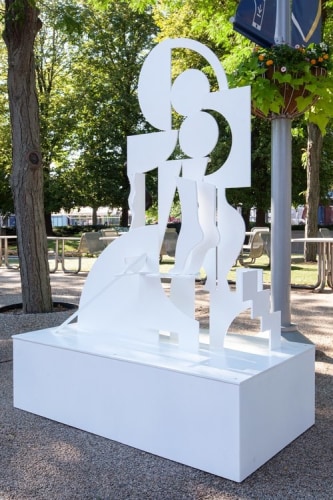
Carolyn Salas, Tippy Toes, 2021
At the U.S. Open, 5 Artists Get a Place in the Sun
Five sculptures, created by artists from underrepresented communities, will find a place in the sun at the Billie Jean King National Tennis Center in Queens until Sept. 11.
By Kalia Richardson
Published Aug. 25, 2022 Updated Aug. 29, 2022
Sculptures by five artists went on view at the U.S.T.A. Billie Jean King National Tennis Center in Flushing, Queens, Tuesday during Fan Week, six days of festivities and qualifying tournaments. The five works, which will remain on view until Sept. 11, are in collaboration with the Armory Show and the United States Tennis Association and serve as an extension of Armory Off-Site and the tennis association’s Be Open social justice campaign, which first presented paintings in 2020 from 18 Black and Indigenous artists at Arthur Ashe Stadium.
This year, some of the sculptures have obvious associations with the sport. In “Now I Won,” by Myles Nurse, a larger-than-life, Wilson-yellow metal tennis player inspired by Billie Jean King is preparing to serve. On Tuesday, when a child began using the baseboard of the sculpture as a trampoline, Nurse said it did not bother him: He was relieved, he said, at the sculpture’s durability. (The sculpture had sold for $12,000 to a buyer in Miami a few days earlier.)
Nurse said he wanted viewers to visualize themselves within the stance. “You could see a champion within yourself by seeing somebody else reaching these amazing feats,” he said.
Welding runs in his family. Nurse’s grandfather ran a metal fabrication business in Jamaica, which he continued after immigrating to the U.S.
“It was in the blood,” Nurse said, “but I’m doing it from a different perspective.”
Carolyn Salas’s work was also inspired by King. She said she remembered watching the fraught, but highly attended, match between King and Bobby Riggs in the 2017 film “Battle of The Sexes.” In her sculpture “Tippy Toes,” Salas compares the daily uncertainties and struggles a woman faces to walking on a tightrope.
“There’s just a constant struggle between that idea of the masculine and the feminine as a woman right now,” Salas said.
Other artists left more open to interpretation.
Jose Dávila’s artwork incorporates both industrial and naturally occurring elements. In his “Untitled Work,” a cerulean blue boulder is sandwiched between two slabs of concrete.
“Many of the boulders I work with, I choose myself while walking in the countryside,” he wrote in a statement. “I’m interested in the primitiveness of rocks, of materials that have always been there, that will always be the same, that show the patina of time.”
“To Rise and Begin Again,” by Luzene Hill, depicts a series of undulating aluminum columns. Hill placed a Cherokee syllabary character above each column to spread awareness of the lyrical language. The columns also resemble the New York skyline, built in part by the Mohawk ironworkers in the early 1900s. “The underlying part of all of my work” is survival, she said.
Hill’s father is Cherokee (her mother is white), and her grandparents were sent to the Carlisle Indian Industrial School in Carlisle, Pa., leaving her and her father unaware of their native tongue. Hill said she had become fascinated by the language’s collectivist, matrilineal perspective.
“Indigenous people have survived 500 years of colonial violence on many, many levels and I’m really happy that’s my DNA,” Hill said in a video call from her home in North Carolina, located on the Eastern Band of Cherokee Indians reservation.
Like Hill, Gerald Chukwuma’s work has direct ties to his heritage. “Ogadiligmma” or the “Town Cryer” is a part of his Igbo Landing series, which pays tribute to the 75 West Africans in 1803 who took control of a slave ship off the Georgia coast and then walked into the water, committing mass suicide. Born in the eastern region of Nigeria, Chukwuma said the West Africans were his ancestors and that determination was an inherent trait.
“When we decided not to be taken as slaves, it wasn’t something that happened by chance,” he said of his ancestors, “It was how we were created. That’s our culture. That’s who we are.”
As visitors holding tennis bags posed next to Chukwuma’s sculpture, buried in sea debris he collected from the Lagos shores, the artist said he hoped that his work would help raise awareness of the neglected Igbo people.
“I’m sure if you listen closely when you get there you can hear him speak,” he said of the sculpture. “I’m sure he’s going to tell stories.”